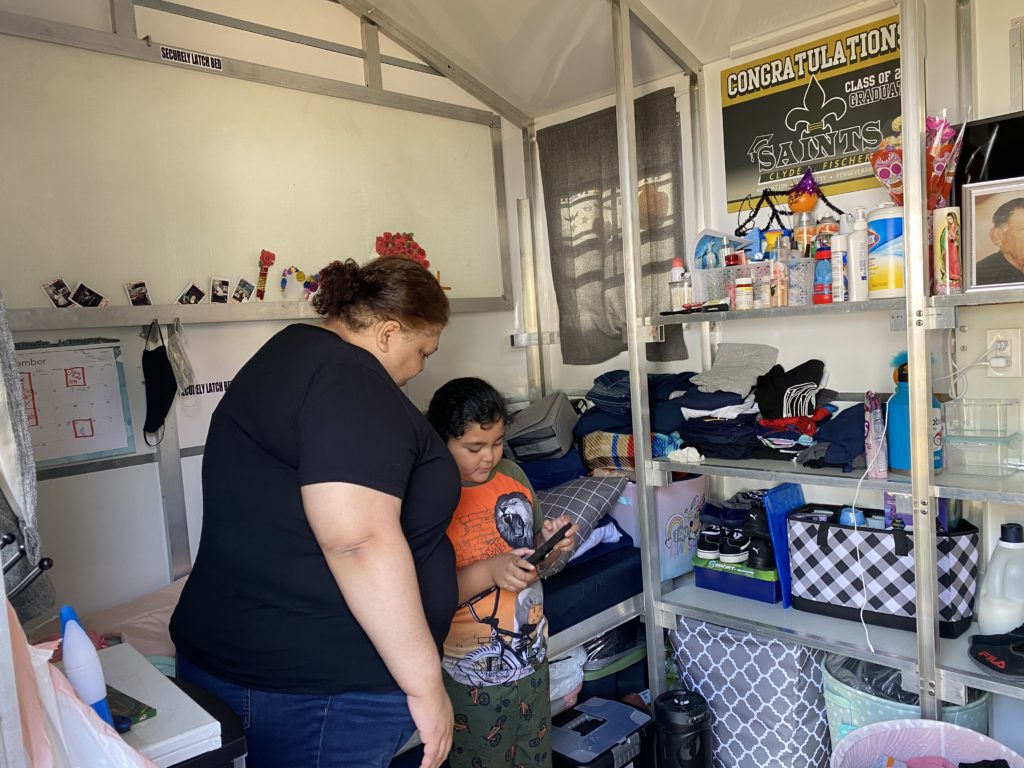Tucked behind the old San Jose City Hall, a tiny home community is lifting local families off the streets.
A neighborhood of roughly 60 residents in 25 units, Casitas de Esperanza—or tiny homes of hope—is a model of how Santa Clara County can help some of the most vulnerable unhoused people, residents at the site said.
The community, and the on-site programs, is “a blessing” for single mom Maria Castaneda and her three children.
“It was an instant relief for us because all four of us didn’t have to share the same mattress anymore,” Castaneda told San José Spotlight. “When we got the call, we said ‘yes’ immediately.”
Castaneda and her kids, who are 18, 15 and 7, have stayed at the site since March. Her family of four was among thousands of South Bay residents who found themselves sleeping on couches and in shelters for years because they couldn’t afford the sky-high rent in San Jose.
The homelessness crisis exploded in Santa Clara County in 2019 as the county recorded more than 9,700 unhoused people. The problem has only gotten worse since the COVID-19 pandemic, advocates said.
In February, Santa Clara County partnered with San Jose-based youth advocacy nonprofit Amigos de Guadalupe and other groups such as Project WeHope, which provides showers and laundry services on site, to open its first ever tiny home community.
The county spent $1.4 million on the pilot program and has budgeted another $1.6 million for the next two years in operational costs. The program welcomes both families with young children and adults.
The program has already seen success. This week, Castaneda’s family will get their keys to a rental apartment in the Alum Rock neighborhood, a place they can call home.
“I’m so grateful to have been here because I got the help that I needed,” Castaneda said. “And we don’t get to go back and be homeless.”

A sense of community
Castaneda can’t remember the last time her family had a home. When the pandemic hit, they bounced from one shelter to another for months, she said.
On a sunny Friday morning, as her youngest son Jesus, 7, was brushing her hair, Castaneda recalled how moving into Casitas de Esperanza was a turning point for the whole family.
“I was emotionally drained,” Castaneda said. “But I was able to talk to my case manager, who told me that I’m going to be OK, and my kids too. That’s how I got through.”
A tiny home at the site costs roughly $10,000, officials said. Each unit has four foldable beds, a heating and cooling unit and shelving. The site also provides daily meals, WiFi and other basic needs.
The site is currently hosting 20 adults and 40 children, ranging from 1 to 18 years old. The Castanedas are the fifth family who have found stability—and permanent housing—after living in the site, said Laura Delgado, program director for Amigos de Guadalupe.
“We really believe in building a community with (residents) and providing what we would want for ourselves,” Delgado told San José Spotlight. “A lot of our folks continue to be unhoused because they haven’t been able to build relationships and keep in touch.”
During their stay, case managers on-site helped Castaneda’s children enroll in schools again. They also worked closely with Castaneda to find affordable housing and help with rent and security deposits.
For Castaneda, the tiny home site helps her find a sense of community. It’s her dream job to work at one of the new sites.
“Every morning when I wake up, there’s always a ‘good morning’ or a smile,” Castaneda said of the workers on-site. “All of their hearts are in it, that’s what makes it so special.”

Efforts to expand
Roughly 10 months after launching Casitas de Esperanza, Santa Clara County is looking to expand the program. The Board of Supervisors unanimously approved a plan last week to identify new sites in the county for other tiny home communities.
In September, Santa Clara County approved a multi-million contract with LifeMoves, the region’s largest temporary housing provider, to replicate an existing shelter site made out of shipping containers in Mountain View at 10 other locations across the county.
“This is one of our interim housing success stories,” Supervisor Cindy Chavez said of the tiny home site last week. “We’re looking for how to both replicate and expand because we know we need more interim housing to make sure that we can get families off the street.”
Castaneda looks forward to celebrating the first holiday season in her new home. The family recently bought an ornament to celebrate the good news. “2021—First Christmas in our new home,” it reads.
Contact Tran Nguyen at [email protected] or follow @nguyenntrann on Twitter.



Leave a Reply
You must be logged in to post a comment.